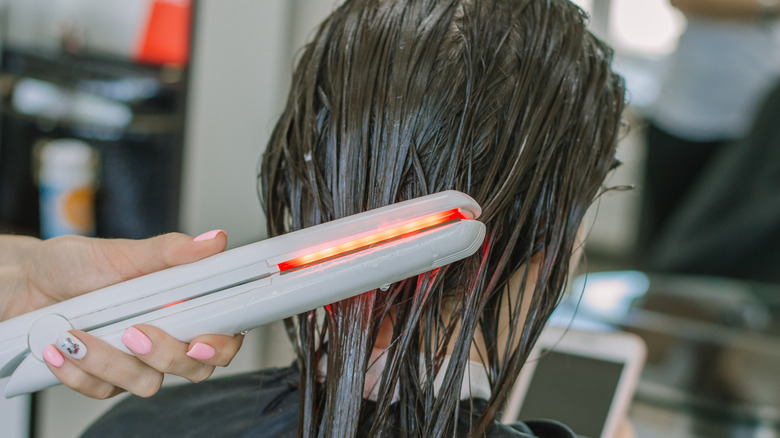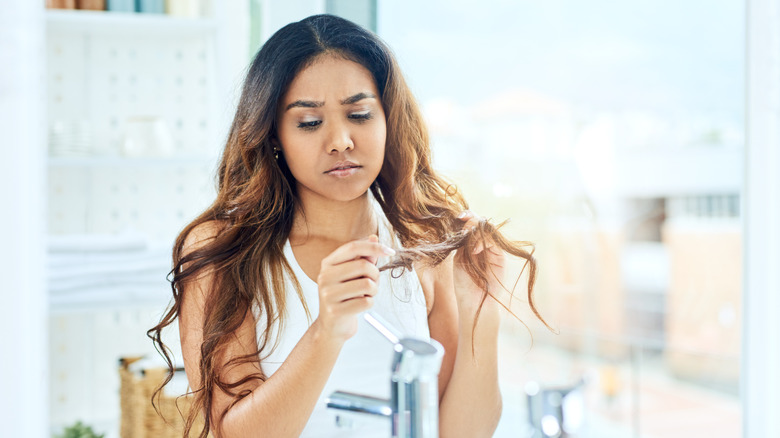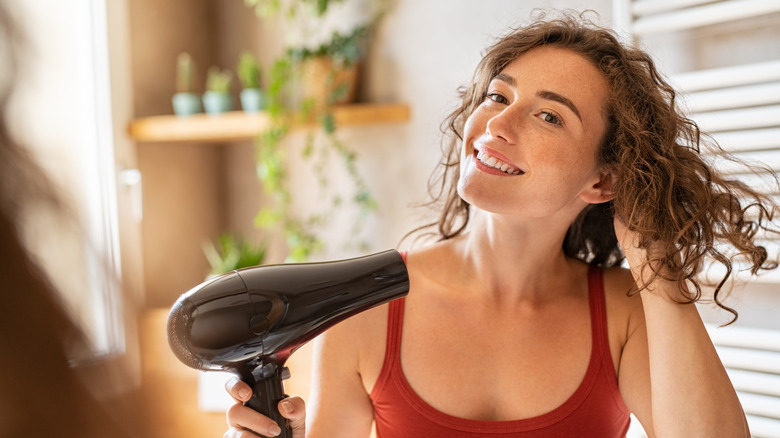Why Straightening Wet Hair Is A Huge No-No
Have you ever been in a rush and straightened your hair while it's still wet? It may seem like an innocent way to save time, but this can cause irreversible damage to your once-healthy hair. Hot tools all cause a degree of damage to your hair, whether your hair is dry or not. But when your hair is wet, Head & Shoulders explains that it is much weaker than normal, which means that it's also much easier to damage it.
When hair is damaged, as a result of straightening it when wet or other common causes, it can feel dry and coarser than usual (via Wella). Damage can also lead to split ends, as the hair will be more likely to break, and the hair can feel finer overall due to shedding. Don't wait to notice these signs before you stop straightening your hair when it's wet, as NuMe explains that you can't reverse the damage your straightener has done because it changes the keratin in your hair on a molecular level. All you'll be able to do is wait for the frizz to grow out and chop it off.
No one wants to be stuck with split ends that look like they've been fried to a crisp, so the best move is to leave straightening until when your hair is well and truly dry.
Straighteners boil the water trapped in your hair
Straightening wet hair is a huge no-no. When you wash your hair, water is absorbed by your strands and stored in the cortex, per Lab Muffin Beauty Science. Then if you use your flat iron on it before letting your mane completely dry, the moisture will heat up past boiling point. This occurs because water only needs to be warmed to 212 degrees Fahrenheit to boil. Meanwhile, the average straightener reaches between 365 to 446 degrees. Since your styling tool is so hot, the moisture in your hair doesn't have enough time to evaporate safely, which causes your cuticle to burst open like "popping corn" because the water within grows bigger as it changes to a gas.
"Hair is weakest when it's wet, and high heat from a straightener can turn the water in the hair into steam, leading to hair breakage and damage to the cuticle," hairstylist Dawna Jarvis told Byrdie. "This can result in frizz, split ends, and sometimes even a burnt smell." The steam and crackling sound that occurs as you run the flat iron down each strand is a warning to stop what you're doing.
Unfortunately, the damage only worsens the more times you straighten wet hair. When your strands are broken, they'll hold on to even more moisture, which then creates a greater amount of damage when it boils.
Use a blow dryer before running a straightener over it
You should never straighten wet hair, even if you're in a rush to get out of the house. Ideally, you should wait for your strands to air dry and then apply a heat protectant before styling it with your hot tools. This will create a barrier which will protect your hair from some of the heat from the straightener, locking in the moisture, per SkinKraft. However, not everyone has the time to sit around all day waiting for their hair to dry. That's when your blow dryer is needed.
Start by towel drying your hair to remove as much moisture as possible. Doing this will speed up the whole process. The less water in your strands, the quicker it will dry and the less weak it will be. L'Oréal Paris explains that you can straighten your hair with a blow dryer by using the concentrator nozzle attachment. With a round brush in one hand and your blow dryer in the other, begin to dry the hair in sections. Make sure to swivel the brush as you work your way down each strand so it can straighten your hair, too. Otherwise, blast your hair without the nozzle to dry it, and then continue straightening your hair with your flat iron. Deseo Salon & Blowdry recommends refraining from using the highest heat setting on your dryer and opting for salon-quality brands in order to reduce the damage.


